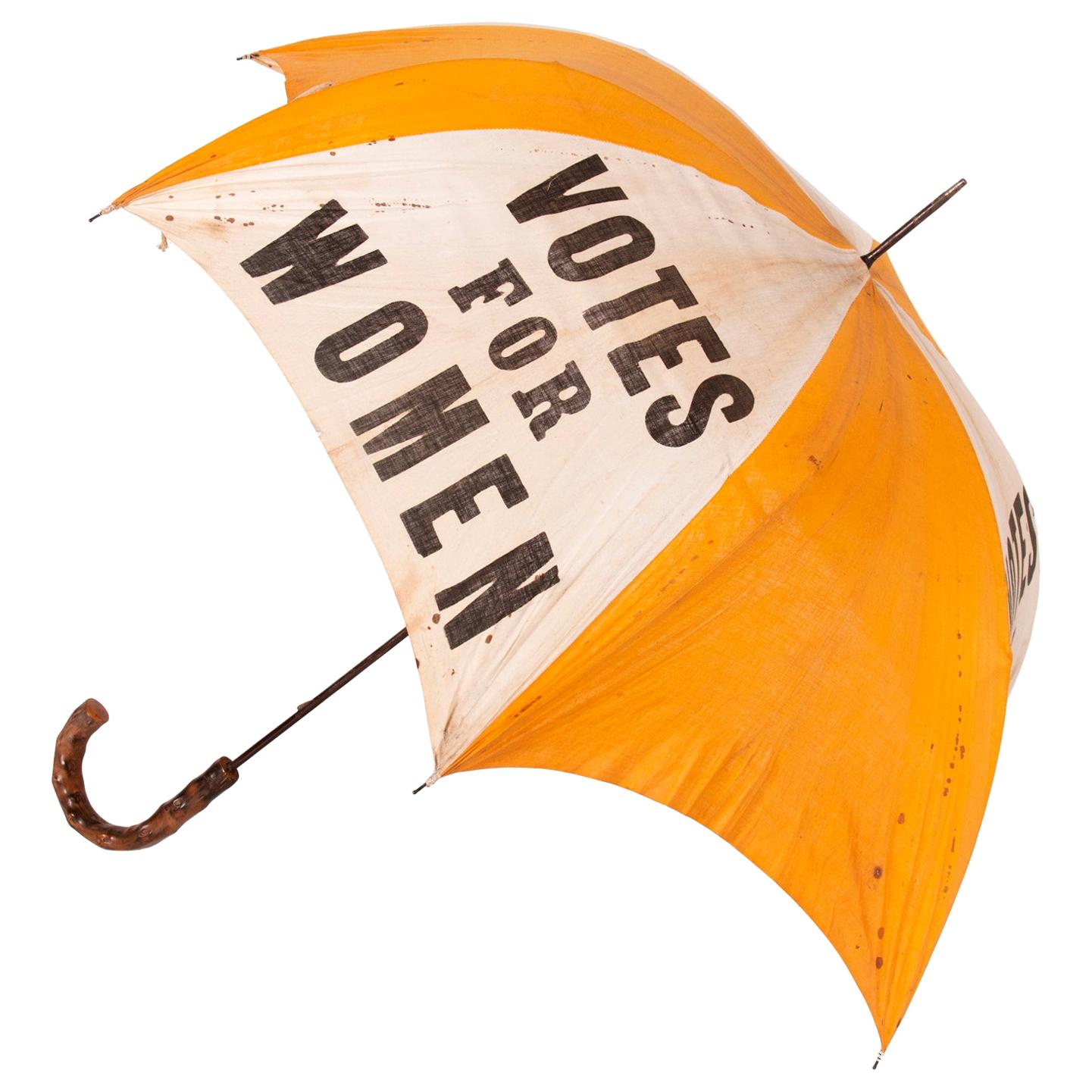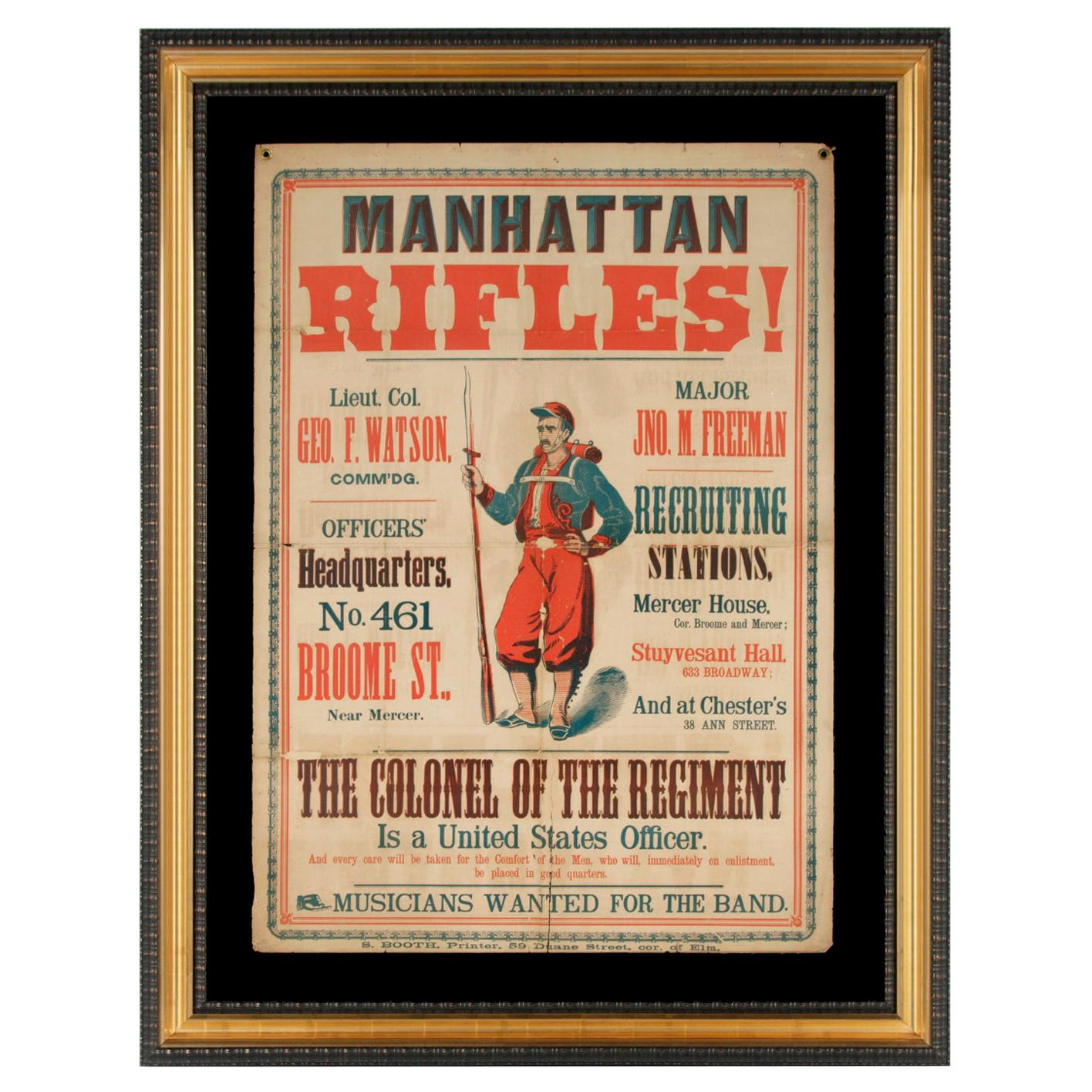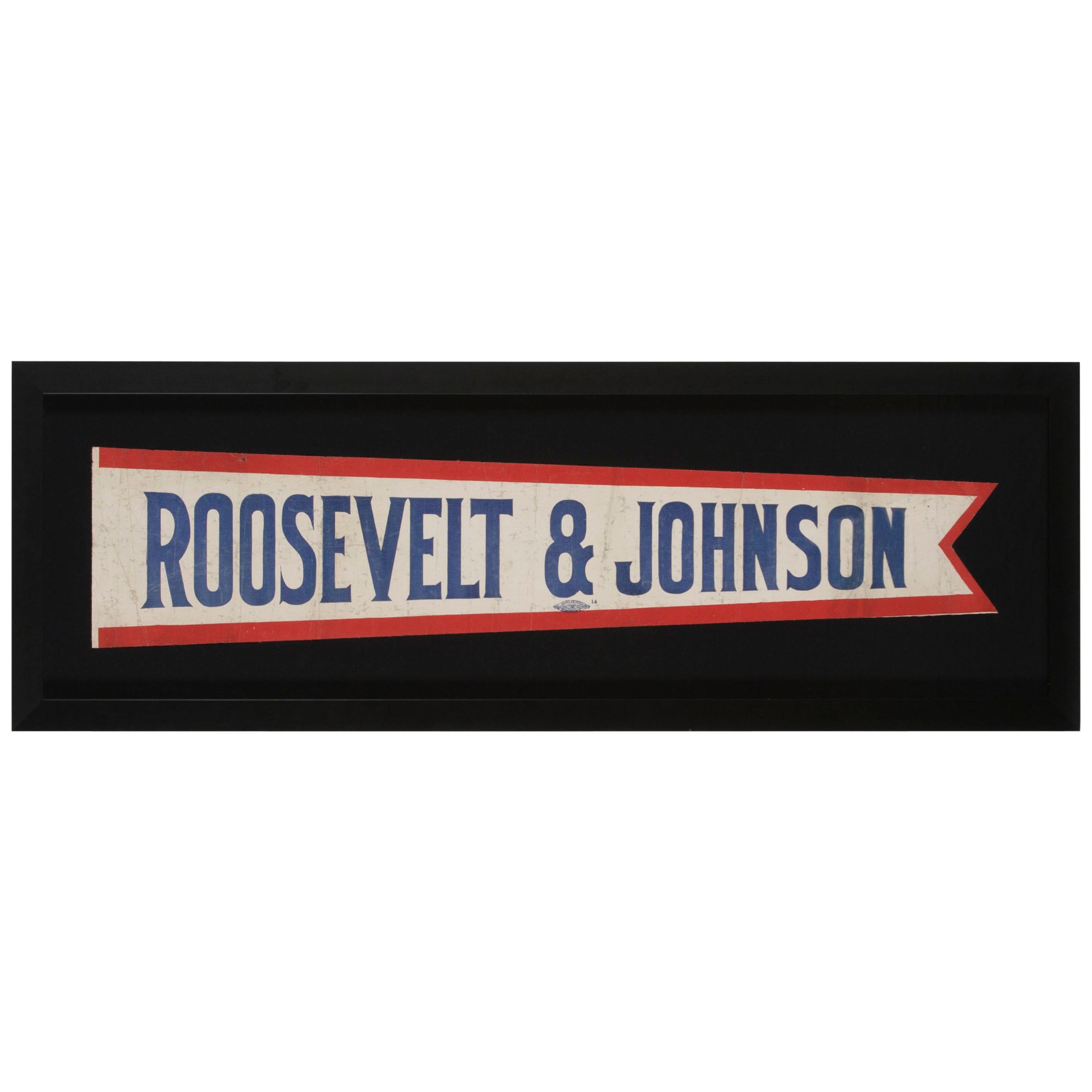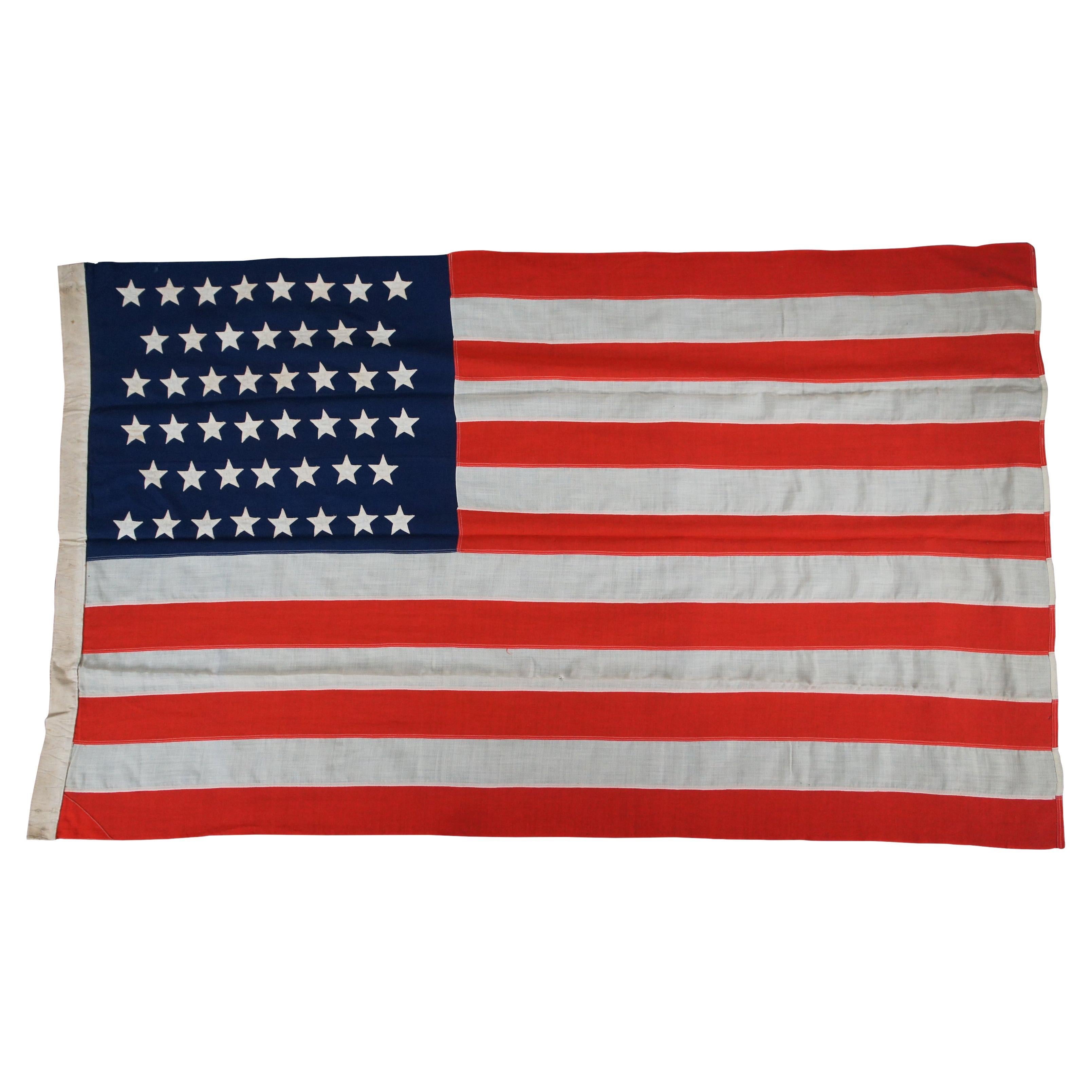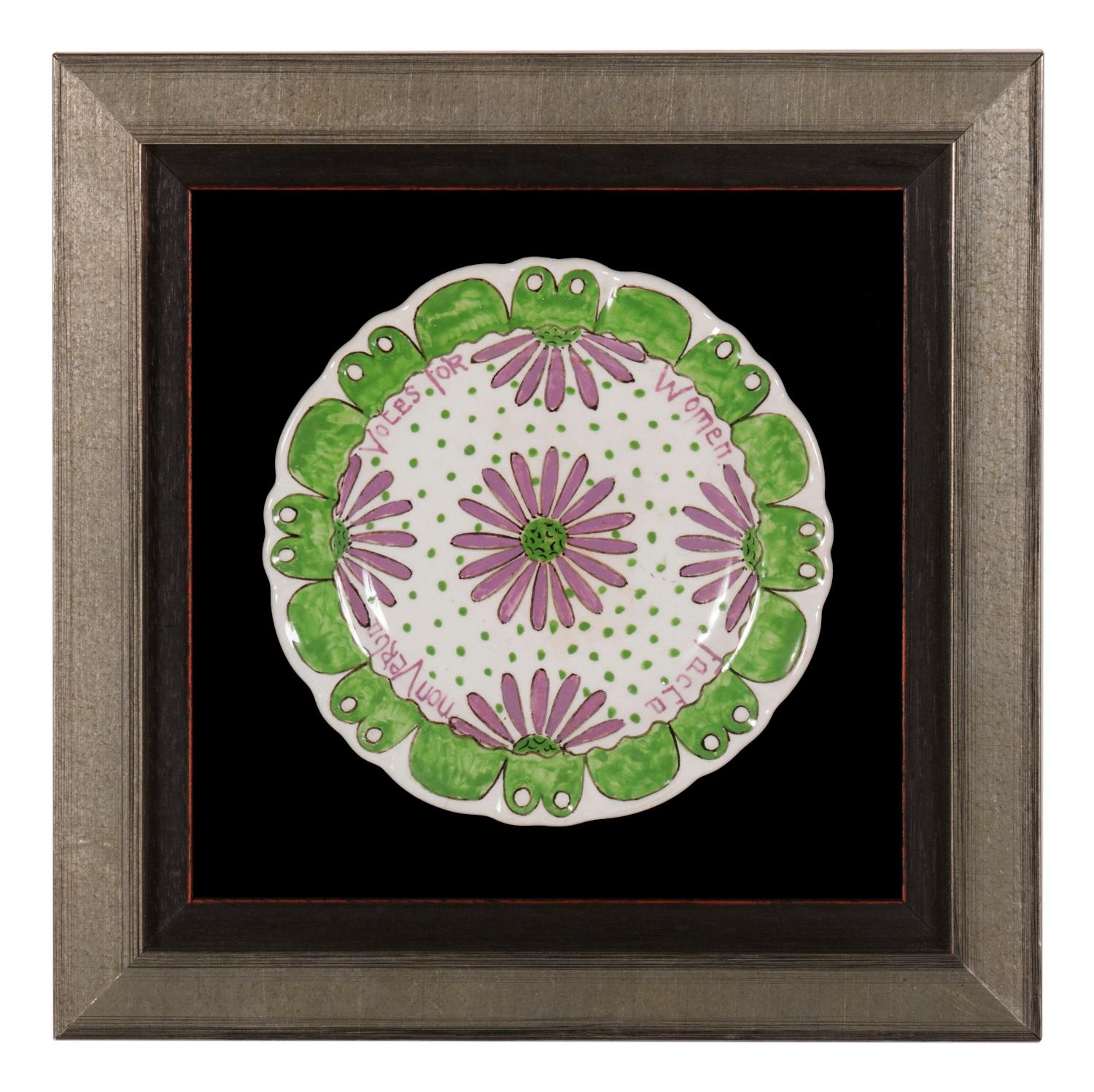Items Similar to "Equal suffrage for Michigan in 1916" Advertising Fan for the Bissell Company
Want more images or videos?
Request additional images or videos from the seller
1 of 7
"Equal suffrage for Michigan in 1916" Advertising Fan for the Bissell Company
About the Item
"EQUAL SUFFRAGE FOR MICHIGAN IN 1916," ADVERTISING FAN FOR THE BISSELL 'CYCO BALL BEARING CARPET SWEEPER,' COMMISSIONED BY ANNA BISSELL (1846-1934), AMERICA'S FIRST FEMALE CEO
Oriental-made, twill-woven silk fan with gilt lettering that reads : "Bissell's 'Cyco Ball Bearing Carpet Sweeper' makes sweeping easy," set within an interesting, open, geometric design. A purposefully curved, paper label beneath was applied by the "Michigan Equal Suffrage Association, Kalamazoo, 405 So. Burdick St.," whose byline is along the bottom. On it, a terrific message reads:
"OVER 100,000 WOMEN pay taxes in Michigan on property assessed at $177,596,938. In 1910 OVER 175,000 MICHIGAN WOMEN signed a petition sent to Congress asking for Equal Suffrage. 247,373 MICHIGAN MEN voted for Equal Suffrage in 1912. MICHIGAN WOMEN WANT TO VOTE. MICHIGAN MEN SHOULD HELP THEM. The good of the state demands the CO-OPERATION of MEN and WOMEN. Equal Suffrage is coming. LET MICHIGAN LEAD not FOLLOW."
Melville and Anna Bissell ran a crockery and glass shop in Grand Rapids, Michigan. Tired of sweeping dust off the floor, Melville invented a carpet sweeping machine, which he patented in 1876. This pre-dated electric counterparts by approximately 50 years. Customers frequently having asked if they could somehow acquire one, production of the sweeper began on the shop's second floor in 1883. When Melville passed of pneumonia at the young age of 45, in 1889, Anna took over the company, becoming one of America's first female executives. In 1919 she formally became chairman of the firm, which made her our nation's first female CEO.
Michigan had a storied history in the Suffrage movement. In 1866, Michigan's first women's suffrage bill was defeated by just one vote in the Michigan State Legislature. Four years later, in 1870, the Michigan State Woman Suffrage Association was formed in 1870 in Battle Creek, home of the Kellogg Company and in close proximity to Kalamazoo and Grand Rapids. In that same year, the state Legislature passed its first suffrage bill, only to have it voted down by then-Governor Henry Baldwin. Susan B. Anthony and Elizabeth Cady Stanton traveled throughout the state in the 1870's and 80's, mobilizing and inspiring Grand Rapid's resident Emily Burton Ketcham. In 1884, the Michigan Equal Suffrage Association (MESA)--the organization advertised on this fan, was formed in the city of Flint, and in 1899, Ketcham, who had become president of MESA, hosted the state convention in Grand Rapids. Local business women and philanthropist, Anna Bissell, was a natural fit for the suffrage movement and one of its strong supporters. In addition, the Bissell name and product were fast becoming well respected by women across America.
The fan, the Bissells, and the Michigan Equal Suffrage Association are connected with both Kalamazoo and Grand Rapids. Melvin Bissell opened a grocery store in Kalamazoo with his father, Alpheus, in 1862. This is where he met and married Anna. He sold the store in 1869 and, having begun to produce and sell stoneware, he and Anna moved to Grand Rapids to open the crockery store in 1870. In 1916, the year in which this fan was produced, the president of the Michigan Equal Suffrage Association was Mrs. Orton H. Clark of Kalamazoo. MESA's annual convention was held in Grand Rapids, and it would seem that Anna Bissell commissioned and gifted the fans for this event. As the fans are hand-painted, imported, and lettered in gold gilt, it would appear that Anna spared little expense for the celebratory objects for use in her local community, advertising the Bissell name and MESA.
The message on the fan is very well formulated and delivered. The organization seems to have approached the subject of Suffrage in a scholarly fashion. In 1911, Harry E. Hunt authored a book entitled "Michigan Laws Relating to Women And Girls: A Comprehensive Digest of the Statutory Law And Amendments There to as They Relate to Women and Girls ; also, Pointed Decisions of the Supreme Court of Michigan Affecting Same," published by MESA in both that year and 1915. During WWI (U.S. involvement 1917-18), work by women in support of the war effort garnered a lot of male endorsement across the nation for woman suffrage, something that wasn't lost on Michigan voters. A woman state suffrage law appeared on the November 1918 Michigan ballot and was passed by a margin of approximately 55%. After the 19th Amendment, approving suffrage, was passed by Congress on June 5th, 1919, Michigan became one of the first three states to ratify the decision just 5 days later, on June 10th (sources differ as to whether Michigan was technically the second or third state, but all three approved on the same day). It would not be until more than a year later, on August 18th, 1920, when the required count of 36 states had ratified and the amendment became law.
Anna Bissell passed in 1934.
Mounting: The fan was mounted and framed within our own conservation department, which is led by expert staff. We take great care in the mounting and preservation of flags and related textiles and have framed thousands of examples.
The two-part frame consists of a black-painted and hand-gilded Italian molding, to which a flat profile molding, made of Caribbean mahogany, with a surface that is nearly black, with reddish undertones and highlights, was added as a liner. The frame was converted into a deep shadowbox to accommodate the object. The glazing is U.V. protective acrylic.
Condition: There are splits in the brittle, silk fabric, accompanied by modest to moderate foxing and staining. There is wear and fading of the paint on the handles. The great rarity of the object well-warrants the condition
Frame Size (H x L): 16.75" x 21".
- Dimensions:Height: 16.75 in (42.55 cm)Width: 21 in (53.34 cm)Depth: 3 in (7.62 cm)
- Materials and Techniques:
- Place of Origin:
- Period:1910-1919
- Date of Manufacture:1916
- Condition:See item Description.
- Seller Location:York County, PA
- Reference Number:
About the Seller
5.0
Recognized Seller
These prestigious sellers are industry leaders and represent the highest echelon for item quality and design.
Established in 1991
1stDibs seller since 2008
61 sales on 1stDibs
Typical response time: 10 hours
- ShippingRetrieving quote...Ships From: York County, PA
- Return PolicyThis item cannot be returned.
More From This SellerView All
- Rare Yellow & White Suffrage Parasol with "Votes for Women" TextLocated in York County, PAEXTRAORDINARILY RARE, YELLOW & WHITE, SUFFRAGE PARASOL / UMBRELLA, WITH “VOTES FOR WOMEN” TEXT, DISTRIBUTED BY THE NATIONAL AMERICAN WOMEN’S SUFFRAGE ASSOCIATION UNDER ANNA HOWARD SHAW’S LEADERSHIP [HEADQUARTERED IN NEW YORK], CIRCA 1913-1915: In the world of Suffrage memorabilia, parasols and umbrellas are known to have been produced, but hardly any exist. Made in both Britain and America, most of the organizations known to have commissioned them did so with white or purple, green, and white, utilizing the traditional British colors. In America, some of these can be identified to the Women’s Political Union of New York, New Jersey, and Connecticut. As for those in the traditional American colors of golden yellow and white, typically with black text, examples are known to have been produced and sold by the National American Women’s Suffrage Association (NAWSA), beginning in the summer of 1913. According to author and expert Ken Florey, the organization peddled them for “one dollar each or ten dollars a dozen…[promoting] them as good for advertising the cause at street meetings, summer resorts, and county fairs. The design consisted of yellow and white in alternate sections, with “Votes for Women” in the white sections.” Florey goes on to explain how some umbrellas in this style are known with names of states hand-painted in the yellow panels. I am aware of Oregon and Idaho. Florey also indicates that one is known for Alaska. His discussion of the subject, and an illustration of the Idaho example, appear in his book, "Women's Suffrage Memorabilia" (2013, McFarland & Co., North Carolina), on pp. 192 and A8, respectively. The Oregon example, which have seen and held first-hand, is illustrated in "The Keynoter: Journal of the American Political Items Conservators," Summer/Fall/Winter 2008 (Women's Suffrage Special Triple Issue), Vol. 2008, No. 2-4, p. 110. In “Woman Suffrage Memorabilia,” Florey describes a heavy demand for parade accoutrements in the 19-teens. Despite the supposed numbers in which these yellow and white umbrellas were likely to have been produced, this is the only example that I am aware has actually surfaced with the “Votes for Women” text only and no state names. This makes it far more universally desirable. A period image survives in the Albert R. Stone Negative Collection, Rochester Museum & Science Center (Rochester, New York,) of a women carrying parasols in this style on Main Street West in that city on August 15, 1914. The marchers, masked, were described as wearing yellow dominoes (nun-style dresses) and carrying yellow parasols. According to museum catalogers, “The outside parasols are plain; those on the inside have the inscription, "Votes for women". The first group, in yellow and blue dominoes, advertised the speech and visit of Dr. Anna Howard Shaw [this would be members of the Empire Campaign Committee]. The second group carried placards with the names of equal suffrage states and the dates when they adopted votes for women. The Club Theatre, whose sign advertising "Burlesque" is clearly visible behind the marchers, occupies the premises at 75 Main Street West formerly occupied by the Shubert Theatre.” The National American Women’s Suffrage Association was formed in 1890. It represented a merging of the two largest Suffrage groups in America before that time. These were the National Woman Suffrage Association (NWSA), formed in 1869 by Susan B. Anthony and Elizabeth Cady Stanton, and the American Woman Suffrage Association (AWSA), also formed in 1869 by Lucy Stone and her Husband, Henry Brown Blackwell, Henry Ward Beecher, and others. Stone’s daughter, Alice Stone...Category
Mid-20th Century North American Political and Patriotic Memorabilia
MaterialsCotton
- Paper Suffrage Pennant with Bold and Whimsical Western Style Lettering, ca 1915Located in York County, PAUnusual paper suffrage pennant, with bold and whimsical, western style lettering, circa 1915 American Suffragette pennant, in a very rare format, with text that reads “Votes for Women,” in a combination of two bold, Western-style fonts. Made of golden yellow paper, with the lettering printed in black, the profile is an unusual one. Linear for approximately 2/5 of its length, the remainder tapers to a point. An example in this style is documented in "The Keynoter: Journal of the American Political Items Conservators," Summer/Fall/Winter 2008 (Women's Suffrage Special Triple Issue), Volume 2008, Number 2-4, p.133. This periodical is the best printed reference that presently exists on Suffrage objects. Golden yellow was the customary color of the suffrage movement in America, a tradition that began with the first actual campaign to give women the right to vote. This took place in 1867 in Kansas, the first state to hold a referendum on the issue when suffragists Susan B. Anthony and Carrie Stanton focused their efforts there and wore sunflowers—the state flower—in a show of support, as well as yellow ribbons. The flower was an appropriate emblem for a rising sun and growth, which led to its use in other states, and the color carried over to many other objects employed in the campaign for years to come. In England, green, white, and purple / violet were introduced in 1908 and became the colors of the movement, which gave way to a nice acronym for “Give Women the Vote.” Various groups used these colors also, in the States, sometimes substituting golden yellow for green. Mounting: The textile was mounted and framed within our own conservation department, which is led by expert staff. We take great care in the mounting and presentation of flags and related textiles and have preserved thousands of examples. This is a pressure mount...Category
Vintage 1910s American Political and Patriotic Memorabilia
MaterialsPaper
- "Votes for Women: Suffrage Pennant ca 1912-1920Located in York County, PAAmerican Suffrage movement pennant, with a standard, triangular taper. Made of yellow felt, with tapered letters that read simply: "Votes for Women," bo...Category
Early 20th Century American Political and Patriotic Memorabilia
MaterialsFelt
- Colorful Civil War Recruitment Broadside for the "Manhattan Rifles"Located in York County, PAMASSIVE & COLORFUL CIVIL WAR RECRUITMENT BROADSIDE FOR THE "MANHATTAN RIFLES,” WHICH MUSTERED INTO 43RD AND THE 57TH NEW YORK INFANTRY DIVISIONS ...Category
Antique 1860s American Political and Patriotic Memorabilia
MaterialsPaper
- Elongated Pennant Made for the 1912 Presidential Campaign of Roosevelt & JohnsonLocated in York County, PAELONGATED PENNANT MADE FOR THE 1912 PRESIDENTIAL CAMPAIGN OF THEODORE ROOSEVELT & HIRAM JOHNSON, WHEN THEY RAN ON THE INDEPENDENT, BULL MOOSE / PROGRESSIVE PARTY TICKET: Elongated,...Category
Vintage 1910s American Political and Patriotic Memorabilia
MaterialsCotton
- Suffragette Plate, "Deeds Not Words" & "Votes for Women", The Only Known ExampleLocated in York County, PAENGLISH PORCELAIN SUFFRAGETTE PLATE WITH "DEEDS, NOT WORDS" AND "VOTES FOR WOMEN" SLOGANS, ONE-OF-A-KIND AMONG KNOWN EXAMPLES, CA 1905-1918 English porcelain plate, made for the Wo...Category
Early 20th Century English Political and Patriotic Memorabilia
MaterialsPorcelain
You May Also Like
- Antique 46 Star WMH Horstmann Company United States of America Flag 83"By HorstmannLocated in Dayton, OHAntique forty six star large wool American flag by Horstmann Company, circa 1908-1912. Horstmann firm was founded by William H. Horstmann (1785-1850), who had immigrated to Philadelphia from Germany. Horstmann bought out a local swordmaker in 1828 and thereafter entered the military goods field. The firm benefitted from the Civil War, becoming the largest military goods supplier in the nation by 1864. WILLIAM H. HORSTMANN & SONS, Manufacturers of Dress Trimmings and Military Goods. 5th & Cherry Streets, Philadelphia, PA. This house was founded, in 1815, by William H. Horstmann, a native of Cassel, in Germany. He had learned the trade of silk-weaving in France, and, emigrating to the United States in the above-mentioned year, established himself in Philadelphia as a manufacturer of fringe, laces and trimmings of various kinds. He married the daughter of Frederick Hoeckly, a German settler in Philadelphia, and also a manufacturer of fringe, coach-lace and tassels. He devised several improvements in this trade, especially by introducing varieties in the styles and patterns of this class of goods, there being at that time only two patterns used in the trade, which were known as the Jefferson pattern and the Monroe pattern. In 1824, he introduced into this country from Germany the use of plaiting or braiding machines, and about the same time he was the first to introduce into this country the use of the Jacquard loom, for weaving patterns in textile fabrics. His location was in the first instance at No. 50 North Third street, but within a short time he removed to a store next to the Harp and Crown tavern, afterwards known as the City hotel, and continued his business within a short distance of this point for many years. In 1828, he commenced the manufacture of military trimmings as a special department, and this branch has grown to most important proportions, Horstmann's military goods being in demand throughout time country. The firm have also executed large Government contracts in this line for the War and Navy Departments. In 1831, he established a branch house in New York city, and about the same time erected a factory at the corner of Germantown road and Columbia avenue. The factory was continued here until time erection of the extensive building at Fifth and Cherry streets, where the works, salesrooms and offices of time firm now are. This massive structure is six stories high, and extends 140 feet on Fifth street and 200 on Cherry street, and reaches back to Race street. The separate departments into which the business is divided are thirty in number. More than 1000 distinct looms and machines are in use in the building, many of them very costly and some invented and used exclusively by this firm, the motive power being supplied by a steam engine of fifty horse power. The area covered by the works is about 11,000 square feet. Time number of hands employed is very large, about 500. When the erection of a vast factory at this point was first proposed, a strong opposition was made by time holders of the neighboring property. The ancient German Lutheran Church and burying ground, since removed, stood opposite the site, and a bill was introduced into the Legislature to forbid the use of a steam engine within 100 yards of any place of worship. The interests which such a bill would have affected injuriously, especially those of several newspapers, roused a strong opposition to it, and it failed to become a law. In 1845, William H. Horstmann, the founder of the house, retired from the business, and his two sons, William and Sigmund, assumed the management and it was under their direction that the new building, above described, was erected. The goods produced by this house are of almost endless extent and variety. They include goods woven from all the various textile fibres—cotton, wool, silk, etc.—in every style, color and pattern, and are used for an infinite number of purposes. Narrow woven goods are time staple production, made up into material for dresses for both sexes, for use in daily life, and for regalia for ""societies;"" for the costumes of the stage, the upholstering of houses and of carriages, the uniforms of soldiers, together with equipments for the same, and for funeral purposes. The raw material used in the manufacture is to a great extent very costly, and their store rooms often hold as much as $200,000 worth of goods in an unworked state. There are two rooms devoted to power looms in the factory, one for coach lace and one for other styles of weaving, in which about 250 of these machines are constantly running. The braiding machines in the coach lace room are very noteworthy. The cord to be covered with braid is drawn through an opening in time middle of a flat, circular, metallic plate, about 15 inches across. Up to a point on this cord, about a foot above the plate, the threads of the braiding material converge, like the ribs of a tent-roof, and there weave in and out and out and in, as the coating of braid grows, and time covered cord rises and is wound away above. The weaving is accomplished by the motion of the spools below that carry the different threads of the braid. These spools stand in uprights, which are carried round and amongst each other in curved slots in the above-mentioned broad metallic plate. All but two of these spools run in and out among each other, with a swift, easy and intricate motion, mind so rapid that time eye can hardly follow it, while one or two special spools run steadily round and round among time twisting spools with the most extreme swiftness. Many other machines, displaying equally ingenious mechanism, are used in the factory. The various details of equipment manufactured and supplied by this house are also important, both for their number and the superior quality of the manufacture. The one article of swords may be taken as an instance. This trade grew naturally and immediately out of the established army and navy goods department of the works, it being necessary that the sword itself should be furnished together with the sword-belt and other trappings all complete. Every part of the sword and trappings, with the exception of the blade, is made on the premises. The blades are almost all imported from the ancient German sword-blade emporium of Solingen, where, it is said, swords have been made ever since the year 1147, when Count Adolphus of Berg brought home from the East and established there the business of forging Damascus blades. There is in this department a stock of some thousands of blades, of many different patterns and sizes, ready to be set and finished. Any style or sword can be had from this warehouse, from the plainest kind up to a presentation sword...Category
Vintage 1910s American Classical Political and Patriotic Memorabilia
MaterialsWool
- 1868 Map of the Upper Part of the Island of Manhattan Above 86th StreetBy Wm. Rogers Mfg. Co.Located in San Francisco, CAThis wonderful piece of New York City history is over 150 years old. It depicts 86th street and above. It was lithographed by WC Rogers and company. It was made to show what was the Battle of Harlem during the Revolutionary war...Category
Antique 1860s American American Colonial Maps
MaterialsPaper
- "The Second World War, " by Winston ChurchillBy Houghton Mifflin & Co.Located in Austin, TXThe Second World War by Winston Churchill from Houghton-Mifflin Company, Boston. A vintage edition of Winston Churchill's six-volume memoir, The Second World War, for which he was a...Category
Mid-20th Century American Modern Books
MaterialsPaper
- Souvenir of the War 1914-15-16-17-18 BannerLocated in Colorado Springs, COPresented is a stunning textile banner from the first World War, dating to 1918. The square tan cotton cloth is embroidered with two crossed flags, the ...Category
Vintage 1910s Australian Political and Patriotic Memorabilia
MaterialsCotton
- Fathers of the Air Service Authentic Signature Collage, circa 1926-1993Located in Colorado Springs, COPresented is a collage celebrating the men who made an early impact on the formation of America’s Air Service. Complete with signatures by Jimmy Doolittle, Tooey Spaatz, Hap Arnold, ...Category
Late 20th Century American Historical Memorabilia
MaterialsPaper
- 46-Star American Flag Printed in Drum Star ConfigurationLocated in Colorado Springs, COThis is an original 46-Star American parade flag, celebrating Oklahoma statehood. Each star on the flag's canton represents a state in the Union at the time. The official flag design would update every July 4th, to include any new states added to the Union in the past year. Oklahoma, the 46th state, entered the Union on November 16, 1907. As such, this 46–star flag was the official flag of the United States from July 4, 1908, until July 4, 1912. The silk flag has a dark blue canton with 46 white printed stars. The stars are printed in an 7-8-8-8-8-7 row configuration, or “Drum design.” The flag design is completed with 13 alternating red and white stripes, each stripe representing one of the original thirteen colonies. The land that comprises Oklahoma today was added to the United States as part of the Louisiana Purchase of 1803. Throughout the 19th century, the U.S. government relocated Indian tribes from the southeastern United States to the area, and by 1900, over 30 Indian tribes had been moved to what was originally called the Indian Territories. At the same time, ranchers in Texas began to move into the area in search of new pasture lands. Although stipulations in the Indian Relocation Act agreed that the land would forever be Indian Territory, the promise of fertile farmland trumped the government’s promise of sovereignty. On April 22, 1889, they opened the land to settlement by homesteaders, creating a land run in which settlers, called “Boomers,” were allowed to cross the Texas or Arkansas border at a particular hour to claim homesteads. Settlers who illegally crossed the border earlier to stake prime land were called “sooners,” which eventually became the state’s nickname. Wagons and the Santa Fe railroad carried cartloads of men and women to blank town sites and building plots, creating ten thousand-people communities in a matter of days. The following year, the region was further divided into Indian Territory and Oklahoma Territory...Category
Vintage 1910s American Political and Patriotic Memorabilia
MaterialsSilk
Recently Viewed
View AllMore Ways To Browse
The Antique Company
In Good Company
The Antique Furniture Company
Shop For Antique Furniture
Stain For Antique Furniture
1916 Furniture
Good Form Company
Used Furniture Michigan
Antique Patriotic
Patriotic Antique
Painted Advertising Sign
Paint Advertising Sign
Antique Paper Company
Antique Black Memorabilia
Antique Political Memorabilia
Antique Patriotic Memorabilia
Italian Fan
Hand Painted Fans
